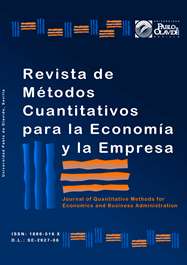Aplicación de una metodología difusa a la negociación de la reforma laboral
DOI:
https://doi.org/10.46661/revmetodoscuanteconempresa.2179Palabras clave:
Reforma laboral, crisis, lógica difusa, labour reform, fuzzy logicResumen
En el presente artículo se desarrolla una metodología basada en técnicas de Fuzzy Logic (lógica borrosa) para la determinación de una solución de consenso aplicada a la negociación de la reforma laboral a partir de las opiniones de Sindicatos, Patronal y Gobierno. El modelo creado se inserta en el ámbito de la metodología a cualitativa o estructural aplicando técnicas basadas en la incertidumbre. Ello resulta especialmente adecuado en un momento como el actual caracterizado por unos cambios sociales y económicos extremadamente rápidos y profundos que nos hacen prácticamente imposible el saber con exactitud todo lo que nos depara el futuro.
Descargas
Citas
Bellman, R.; Zadeh, L. (1970). “Decision Making in a Fuzzy Environment”, Management Science, 17 (4), pp. 141–164.
Berzosa, C. (2009). “Crisis financiera, crisis global”, El País digital, 10/09/2009: http://www.elpaís.com/articulo/opinión/Crisis/financiera/crisis/global/elpepiopi/20090210el pepiopi_4/Tes/
Cabrerizo Lorite, F.J. (2008). Nuevos modelos de toma de decisión en grupo con información lingüística difusa, Tesis Doctoral, Universidad de Granada.
Campa, J.M. (2009) “A por lo importante, que también es lo urgente” [en línea], El Mundo Mercados: http://www.elmundo.es/papel/2009/04/19/mercados/2631682.html [Consulta: 01/06/2009]
Chernoff, H. (1987). Elementary decision theory, Dover Publications, New York.
De la Dehesa, G. (2009). La primera gran crisis financiera del siglo XXI: orígenes, detonantes, efectos, respuestas y remedios, Ariel, Barcelona.
Fondo Monetario Internacional (2009). Vídeo explicativo sobre las perspectivas de la crisis [en línea]: http://www.imf.org/external/mmedia/view.asp?eventID=1370 [Consulta: 03/09/2009]
Herrera, F.; Herrera-Viedma, E. (2000). “Linguistic decision analysis: steps for solving decision problems under linguistic information”, Fuzzy Sets and Systems, 115, pp. 67–82.
Kaufmann A. (1982). Introducción a la teoría de los subconjuntos borrosos, CECSA, México.
Kaufmann A.; Gil Aluja J. (1987). Técnicas operativas de gestión para el tratamiento de la incertidumbre, Hispano Europea, Barcelona.
Kaufmann, A.; Gil Aluja, J.; Terceño, A. (1994). Matemática para la economía y la gestión de empresas, Foro Científico, Barcelona.
Klir, J.; Yuan, B. (1995). Fuzzy Sets and Fuzzy Logic. Theory and Applications, Prentice-Hall International, New Jersey.
Kosko, B. (1995). Pensamiento borroso, Grijalbo Mondadori, Barcelona.
Lazzari, L.; Machado, E.; Pérez, R. (1998). Teoría de la decisión fuzzy, Macchi, Buenos Aires.
Lazzari, L.; Machado, E.; Pérez, R. (1999). “Los conjuntos borrosos: una introducción”, Cuadernos del CIMBAGE, 2, Facultad de Ciencias Económicas, Universidad de Buenos Aires, Buenos Aires.
Merigó, J.M.; Gil-Lafuente, A.M. (2008). “The generalized adequacy coefficient and its application in strategic decision making”, Fuzzy Economic Review, 13 (2), pp. 17–36.
Sánchez, J. (2007). Modelos para la combinación de preferencias en toma de decisiones: herramientas y aplicaciones, Tesis Doctoral, Universidad de Granada.
Zadeh, L.A. (1965). “Fuzzy Sets”, Information and Control, 8, pp. 338–353.
Zadeh, L.A. (1975). “The concept of a linguistic variable and its applications to approximate reasoning”, Part I, Information Sciences, 8, pp. 199–249, Part II, Information Sciences, 8, pp. 301–357, Part III, Information Sciences, 9, pp. 43–80.
Descargas
Publicado
Cómo citar
Número
Sección
Licencia
Derechos de autor 2013 Revista de Métodos Cuantitativos para la Economía y la Empresa

Esta obra está bajo una licencia internacional Creative Commons Atribución-CompartirIgual 4.0.
El envío de un manuscrito a la Revista supone que el trabajo no ha sido publicado anteriormente (excepto en la forma de un abstract o como parte de una tesis), que no está bajo consideración para su publicación en ninguna otra revista o editorial y que, en caso de aceptación, los autores están conforme con la transferencia automática del copyright a la Revista para su publicación y difusión. Los autores retendrán los derechos de autor para usar y compartir su artículo con un uso personal, institucional o con fines docentes; igualmente retiene los derechos de patente, de marca registrada (en caso de que sean aplicables) o derechos morales de autor (incluyendo los datos de investigación).
Los artículos publicados en la Revista están sujetos a la licencia Creative Commons CC-BY-SA de tipo Reconocimiento-CompartirIgual. Se permite el uso comercial de la obra, reconociendo su autoría, y de las posibles obras derivadas, la distribución de las cuales se debe hacer con una licencia igual a la que regula la obra original.
Hasta el volumen 21 se ha estado empleando la versión de licencia CC-BY-SA 3.0 ES y se ha comenzado a usar la versión CC-BY-SA 4.0 desde el volumen 22.










